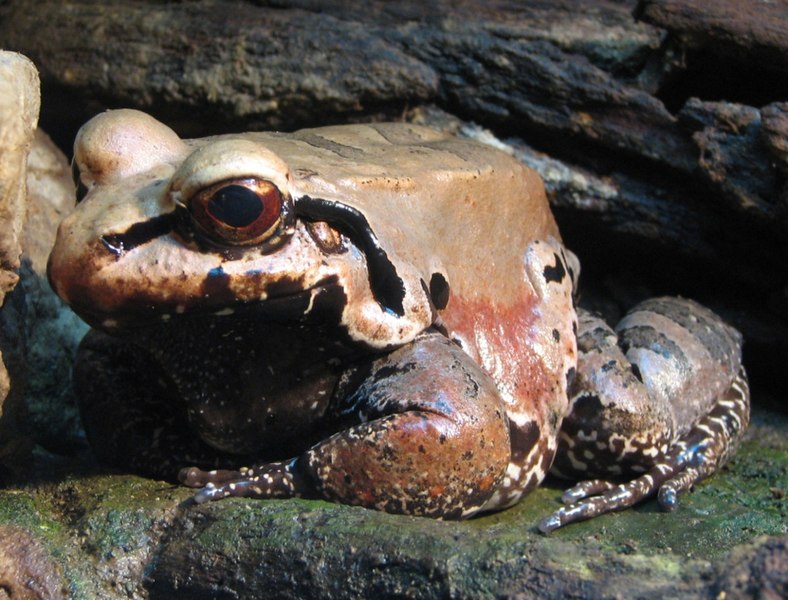The Nosy Be Gecko (Uroplatus ebenaui) is one of the most interesting recent newcomers to the pet trade. However, its unique appearance should not prompt you into a quick purchase, as we have a great deal yet to learn about its care. Today I’d like to review its natural history, as therein lay the key to its proper captive care. In Part II of this article we’ll look at some of \this lizard’s interesting relatives. Read More »
The Natural History and Captive Care of the Smokey Jungle Frog – Part 2
 Please see Part 1 of this article for information on the natural history, amazing reproductive biology (including terrestrial nesting) and captive breeding of the Smokey Jungle Frog (a/k/a South American Bullfrog, Leptodactylus pentadactylus).
Please see Part 1 of this article for information on the natural history, amazing reproductive biology (including terrestrial nesting) and captive breeding of the Smokey Jungle Frog (a/k/a South American Bullfrog, Leptodactylus pentadactylus).
Diet
The hefty, robust adults are capable of taking quite large prey, including small birds, snakes, other frogs, mice and other rodents, scorpions and tarantulas as well as earthworms, roaches, moths and other invertebrates.
Smokey Jungle Frogs they are one of the few animals known to consume the highly toxic Poison Frogs, Dendrobates spp.
I’ve had good success with a diet comprised largely of earthworms, roaches, crickets and wild-caught insects (please see my article on Collecting Feeder Insects). I use shiners and crayfishes as a calcium source, but a pink mouse may be offered every 6-8 weeks if desired. Read More »
The Red-Eyed Treefrog – Notes on Captive Care and Natural History
 This article is one of a series in which I plan to provide a brief introduction to both popular and rarely-kept amphibians, reptiles and invertebrates. I’ll cover such topics as unique habits in the wild, common mistakes or concerns in captive care, pet pros and cons, little-known husbandry tips and so forth. Detailed care articles will follow…until then, I would enjoy receiving your questions and comments. Today we’ll take a look at the Red-Eyed Treefrog, Agalychnis callidryas.
This article is one of a series in which I plan to provide a brief introduction to both popular and rarely-kept amphibians, reptiles and invertebrates. I’ll cover such topics as unique habits in the wild, common mistakes or concerns in captive care, pet pros and cons, little-known husbandry tips and so forth. Detailed care articles will follow…until then, I would enjoy receiving your questions and comments. Today we’ll take a look at the Red-Eyed Treefrog, Agalychnis callidryas.
Night Shows Only!
Ranging from southern Mexico to Panama, this striking beauty (its scientific name translates as “Beautiful Tree Nymph”) has become something of a “rain forest darling”, appearing on more calendars, book covers and travel brochures than any other amphibian. Frog keepers, enamored of its huge, brilliant red eyes and lime-green skin, have taken to it as well. Read More »
The Penn Plax Turtle Pier – a Useful New Basking Site for Turtles and Amphibians

Drawbacks and Advantages of Various Platforms
Since their introduction, I’ve put the first line of basking docks and platforms to good use in my collection and in several of the aquarium and museum exhibits I’ve designed (please see article below). Their only limitations are that large turtles tend to sink them below the surface (which keeps the plastron from drying out completely) and robust individuals sometimes dislodge the platforms from the aquarium’s sides. Read More »
The Natural History and Captive Care of the Smokey Jungle Frog – Part 1
 I’ve studied and cared-for a great many frog species in my time, but count the robust Smokey Jungle Frog, also known as the South American Bullfrog (Leptodactylus pentadactylus), as one of the most beautiful and mysterious of all. I’ve been very fortunate in having bred this frog in captivity, and today will examine its natural history and reproduction. I’ll move on to diet and its unique habits in Part 2.
I’ve studied and cared-for a great many frog species in my time, but count the robust Smokey Jungle Frog, also known as the South American Bullfrog (Leptodactylus pentadactylus), as one of the most beautiful and mysterious of all. I’ve been very fortunate in having bred this frog in captivity, and today will examine its natural history and reproduction. I’ll move on to diet and its unique habits in Part 2.
Range
This frog occurs from Honduras and northern Nicaragua through Venezuela to French Guinea and south to southern Columbia, Ecuador, northern Brazil, Peru and Bolivia. Due to its secretive nature, the southernmost limits of its range are not well known. Read More »
 That Reptile Blog – Reptile, Amphibian and Exotic Pet Care and Information
That Reptile Blog – Reptile, Amphibian and Exotic Pet Care and Information
